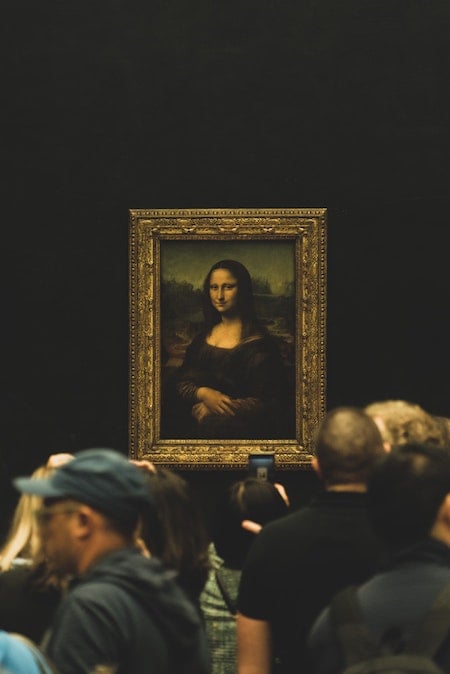Featured in this post
Keep Exploring
Paris, France
Essential Paris
Explore More
A crown jewel of the art world, the Louvre Museum is a must for anyone heading to Paris.
Even if you never set foot within the galleries and exhibition spaces themselves, you’ll delight in strolling around the courtyards of the Louvre Palace and its splendid Tuileries Garden, admiring the signature glass pyramid and the Arc de Triomphe while taking in some fantastic views of the Eiffel Tower in the distance.
But venture inside and you’ll find heavy-hitter Hellenistic art, such as the Winged Victory of Samothrace and Venus de Milo, and an impressive paintings collection showcasing technical mastery and stellar artistic techniques, including Leonardo da Vinci’s Mona Lisa and her infamously enigmatic smile.
There’s also a bevy of rotating Louvre exhibits to keep things interesting—and the upcoming lineup is full of intriguing shows, including the much-anticipated Naples in Paris. Read on for the must-see exhibitions at the Louvre Museum in 2023 and the best permanent collections to check out while you’re there—plus the best ways to fit it all in.

How much time do I need to visit the Louvre Museum?
First things first: Temporary exhibits aside, the permanent collections of the Musée du Louvre are well worth a visit. Art lovers will need at least three or four days to take in all that the French museum has to offer, so planning a visit requires a smart approach.
If your schedule is tight, you might consider joining our Louvre Highlights Tour: Mona Lisa, Venus de Milo & the Crown Jewels. On this two-hour walking tour, you’ll have the chance to skip the long lines at the most popular of all Paris museums, taking in some of its most iconic works of art under the guidance of an expert art historian.
If you have a little more time in the City of Lights, why not come along our Complete Louvre Tour? Over the course of three hours, you’ll visit some of the Louvre’s most important rooms, getting up close and personal with Mona Lisa’s smile as well as hitting a few under-the-radar spots you might’ve missed on your own.
And if you’re keen on taking in some of the museum’s most sought-after works of art without the crowds, our Closing Time at the Louvre: The Mona Lisa at Her Most Peaceful is for you. On this tour, an expert art-historian guide will give you the lowdown on the history of the palace, including an overview of the medieval Louvre, and some of the museum’s most important works of art, including the classic Greek artworks in the Galerie d’Apollon and, of course, that ever so artistically accomplished painting, the Mona Lisa.
What are the Louvre’s can’t-miss exhibits for 2024?
The Louvre Museum’s 2024 temporary exhibition season boasts several stellar shows and perfect timing for the Summer Olympics in Paris. The Olympisme, Modern Invention? Ancient Legacy will feature an exhibition on how the first Olympics came to fruition and how in the name of sport the Olympics have created a worldwide spectacular event. (24 April – 16 September 2024)
Figures of the Fool exhibition will focus on the medieval figure of the fool in art history. The fool has played a part in both religion and social folklore, often depicted as the court jester wearing a cap and bells. (16 October 2024 – 3 February 2025)
Another much-anticipated temporary exhibition slated to open in 2024 is A New Look on Watteau Pierrot, Known as Gilles. The painting is known as a masterpiece by French painter Antoine Watteau. It’s often regarded as a reflection of the 18th century with a cynical, or mischievous appearance. It’s a perfect pairing with the Figures of the Fool showcase during the same timeframe. (16 October 2024 – 3 February 2025)

What are the must-see collections and artworks in the Louvre?
From the decorative arts to classical art and artifacts to pieces showcasing new artistic techniques, the French art museum and former royal palace houses an impressive permanent collection, divided into eight curatorial departments.
Among the most popular are the Egyptian Antiquities department, with its splendid sphinxes and mummies, and the Greek, Etruscan, and Roman departments, treasured particularly for their outstanding collection of original Greek statues and ancient Greek art.
Art historians and casual visitors alike will relish visiting the Sculpture and Painting departments, the former highlighting sculptural works produced before 1850, including the world-famous Dying Slave by Leonardo da Vinci.
The latter focuses on a meticulously curated selection of Western paintings from the 13th to the 19th centuries, including superb representatives of medieval European iconography and pieces from the studios of the Northern European and Italian masters. You can also delve into French history with excellent works of art culled from the French Romanticism Movement.
Original Post Date: November 21, 2022
Featured in this post
Keep Exploring
Paris, France
Essential Paris
Explore More


